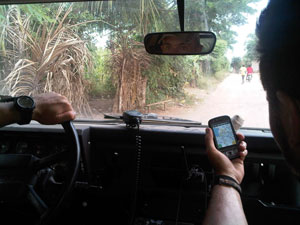REDMOND, Wash. — Sept. 1, 2011 — When Zbyněk Poulíček participated in Microsoft Imagine Cup last year, his dream to make an impact was already coming true — the project his team created with Windows Embedded technologies was helping relief workers during natural disasters halfway around the world.
“The initial intention was to create an interesting project for my diploma work, but Imagine Cup changed my point of view and inspired me to form a team to start the GINA project,” said Poulíček, who is now the co-founder of GINA Software, based in the Czech Republic. “During development, the earthquake in Haiti was a very important milestone when we realized the significant potential of our concept.”
Poulíček and his team members, Petra Černá and Boris Procházka, knew only what they could see on TV about rescue efforts during the January 2010 earthquake. Reports showed emergency workers unable to locate people trapped in destroyed buildings because they lacked the proper communications equipment, demonstrating the need for an information-sharing tool that provided up-to-date information about the situation. The team decided it needed to create a mobile system that improved the efficiency of the rescuers while also ensuring their safety.
Today, relief workers in disaster-stricken countries, including Haiti and Japan, use the geographical information assistant (GINA) mobile application that Poulíček’s team imagined. GINA System provides interactive-mapping software that allows rescue teams to coordinate and exchange geographic information through mobile devices. Similar to a paper map, on which people can draw or stick pins to point out specific coordinates, GINA lets users insert their own locations through pictograms and share their updates with other mobile devices that have the software installed. This real-time technology is ideal for emergency workers and teams who need to have an accurate overview of rescue sites and track people in the field.
Before even competing in Imagine Cup, Poulíček said his team contacted Hand for Help, offering GINA software to assist with search efforts during the Haiti earthquake. When GINA’s interactive mapping features proved successful in Haiti, the team turned its project into a professional endeavor by launching GINA Software. Now the company regularly supports relief agencies, as well as businesses seeking to lower costs for planning logistics and secure field workers and equipment.
The GINA System mobile application runs on Windows Embedded Handheld, which provides a robust and flexible solution that works well with the sturdy, industrial, mobile terminals used by GINA. Windows Embedded Handheld also meets key line-of-business scenarios and boosts productivity of the mobile enterprise workforce by enabling users to capture, access and act on business-critical information where and when they need it.

Relief workers in Haiti use GINA System’s live, interactive mapping software, installed on their mobile device, to efficiently track the disaster site and locate people in the field.
“What people can achieve thanks to advanced technology is what counts, and embedded technologies help transform great ideas into concrete solutions that will help solve severe problems,” said Olivier Bloch, technical evangelist, Windows Embedded at Microsoft. “Embedded technologies can and should enhance processes, getting information shared and analyzed faster and more efficiently, therefore helping solve lots of issues faced in remote locations, where the technologies commonly used in developed countries do not exist.”
The most challenging step for creating GINA System was designing an application that worked in the most desperate circumstances. Windows Embedded platforms and technologies enable developers to create systems that respond to the need for flexibility, connectivity and mobility within harsh conditions and critical situations, such as those created in the aftermath of the earthquakes in Haiti and Japan. By utilizing Windows Embedded Handheld, the team could design its own protocols and data encodings in a familiar development environment and trust that the application would work almost everywhere.
Currently, GINA is used mostly by rescue workers and security professionals for team coordination and safety, but as its client base grows, the company is expanding beyond its original design to meet the needs of other industries based on client feedback. For example, GINA Software intends to use next iterations of the application to collect information about biological hazards in the environment, which the company will then release to the general public.
“GINA System turned from a student project to a serious business very quickly, and it is a great motivation that, with our solution, we can help to make the world at least a slightly better place,” Poulíček said.
To learn more about GINA System and how it can help keep situations under control, visit http://www.ginasystem.com. More information about Windows Embedded products is available at http://www.microsoft.com/windowsembedded/en-us/windows-embedded.aspx.




